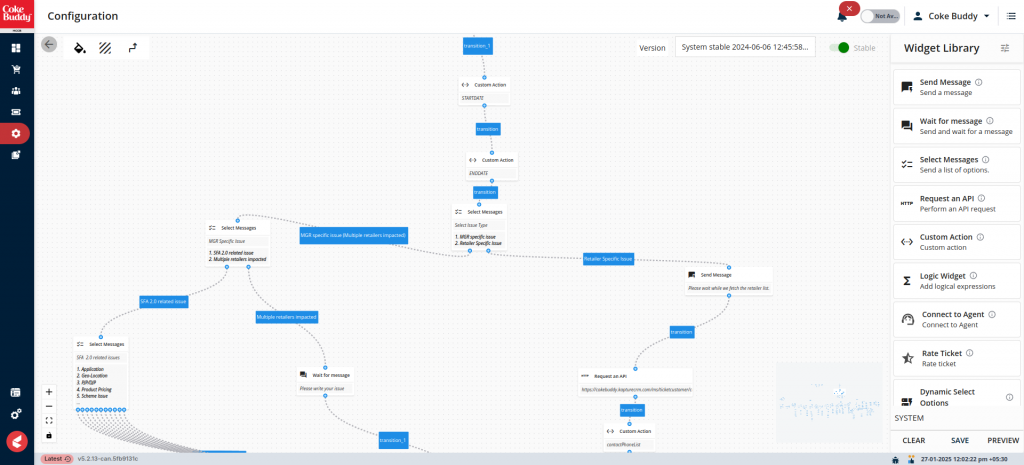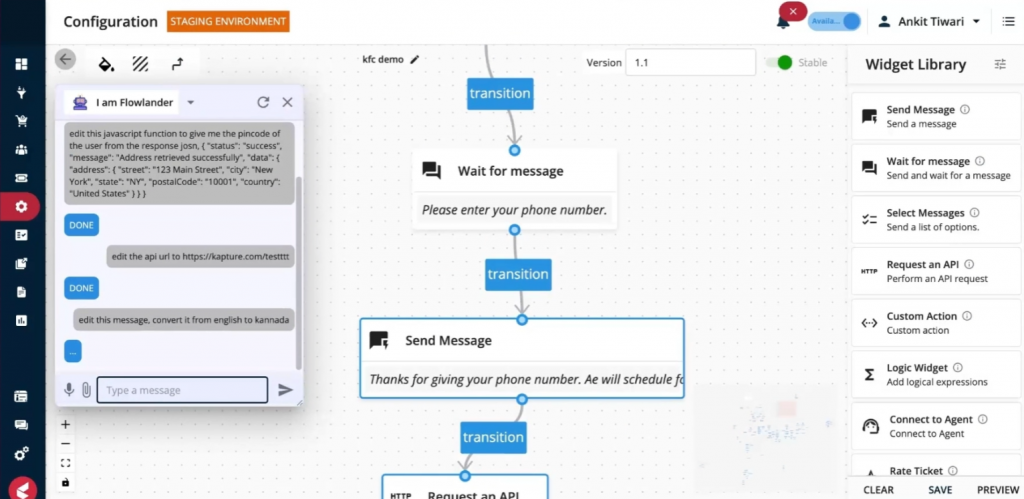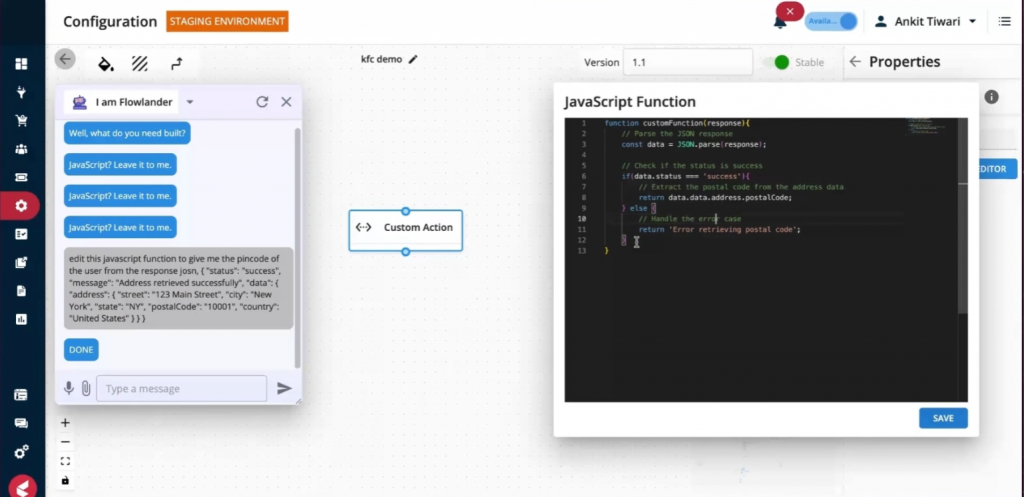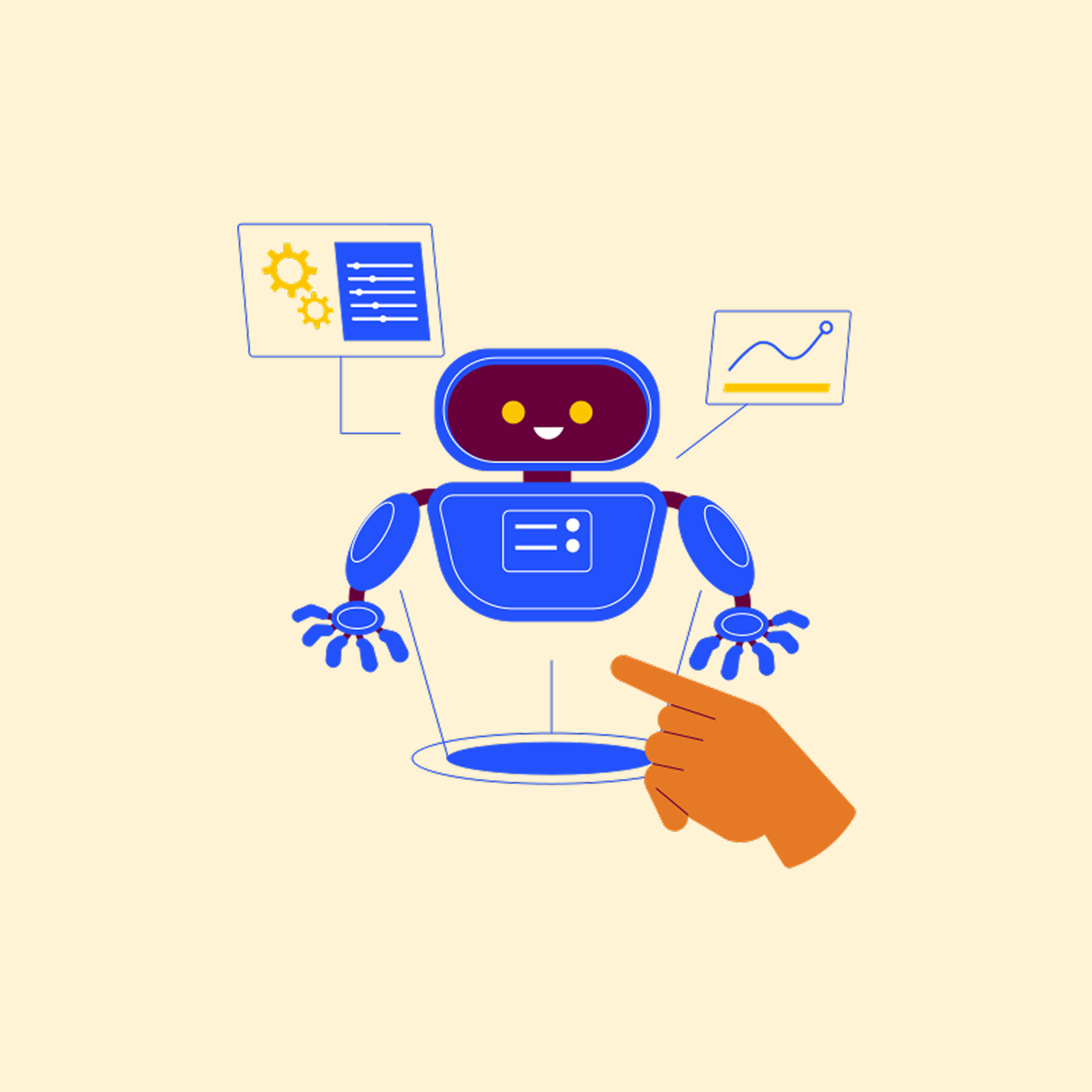Table of Contents
2. The Problem We Wanted to Solve
6. Key Features of the Smart Flow Builder
8. Learn More and Explore the Tool
The process of creating chatbot systems has always required a blend of creativity and technical expertise. With the introduction of the Smart Flow Builder, that process has become significantly more intuitive and accessible. This innovative tool reimagines how we design, manage, and optimize automation and chatbot flows.
What is the Flow Builder?
The Flow Builder is a tool developed by Kapture to enable users to build chatbot flows or automation workflows using a drag-and-drop interface. It provides a variety of options such as:
1 . Sending messages and waiting for customer replies.
2. Quick reply options for quick conversations.
3. Connect to external APIs to fetch data.
4. JavaScript functions that make the chatbot dynamic and personalized for the user.
5. Logic-based flow distribution.
This rich feature set ensures that complex workflows can be designed with ease.
The Flow Builder is a tool developed by Kapture to enable users to build chatbot flows or automation workflows using a drag-and-drop interface. It provides a variety of options, such as:
1 . Sending messages and waiting for customer replies.
2. Quick reply options for quick conversations.
3. Connect to external APIs to fetch data.
4. JavaScript functions that make the chatbot dynamic and personalized for the user.
5. Logic-based flow distribution.
This rich feature set ensures that complex workflows can be designed with ease.

The Problem We Wanted to Solve
Our primary goal was to empower non-technical users to create workflows that involve complex conditional logic. Previously, features like custom actions (e.g., JavaScript functions) required technical knowledge, making project management teams highly dependent on developers. The project implementation team, which closely collaborates with clients to gather requirements, often faced delays due to this dependency.
By making the Flow Builder user-friendly, we aimed to:
1 . Save time for both project implementation and developer teams.
2. Increase productivity.
Initially, we began researching AI-driven JavaScript generation. During this R&D phase, we realized that Large Language Models (LLMs) could do much more than write code—they could help build entire workflows through simple prompts. This insight led us to implement several AI-powered features within the Flow Builder.
Capabilities of the LLM
The AI assistant integrated into the Flow Builder leverages LLM capabilities to streamline and automate workflow creation, making it more intuitive and efficient. With its ability to understand and process natural language, the AI Assistant simplifies the way users interact with the Flow Builder.
1. Create new flows from scratch: Simply describe what you want, and the AI builds the flow for you.
2. Edit existing flows: Make changes to workflows through natural language commands.
3. Convert flowchart images to functional flows: Streamline the transition from brainstorming to implementation.
4. Generate JavaScript code: Get custom logic written based on your input.
With the AI Assistant, the Flow Builder transforms the way workflows are designed, offering unparalleled flexibility and accessibility.
Our R&D Journey
As software developers, we began by exploring the fundamentals of LLMs and how they could be integrated into projects. Here’s how our journey unfolded:
1. Exploration: We explored LLM functionalities provided by platforms like Ollama and OpenAI.
2 . Learning: We studied official documentation and leveraged resources such as YouTube tutorials.
3. Experimentation: We experimented with features like:
– Structured Outputs: Mapping AI model outputs to POJOs (Plain Old Java Objects), where we expect our predefined json to create flow from the AI model.
– Tools/Function Calling: Allowing the model to execute client-side tools for real-time tasks.
– Multimodality: Enabling the model to process inputs from various sources (e.g., text and images).
Implementation Details
Our backend was developed using Java and Spring Boot, leveraging the Spring AI library to integrate LLM capabilities. Key features implemented include:
1 . Structured Outputs: Used to generate JSON required for flows, based on detailed descriptions.
2 . Tools/Function Calling: Enabled the model to execute specific functions for real-time results.
3. Multimodality: Facilitated the conversion of flowchart images into functional workflows.
4. JavaScript Code Generation: Implemented general chat-based functionality for generating custom logic.
We used the Spring AI SDKs for OpenAI and Ollama by referring to the official documentation, which provided the flexibility needed to bring these features to life.
Key Features of the Smart Flow Builder
Meet Flowlander, our Intelligent Flow Creation Assistant! Designed to revolutionize how you build and manage chatbot flows. Whether you’re creating flows from scratch using image-based prompts, refining existing processes, or diving into JavaScript for deeper customization, Flowlander makes it seamless and intuitive.
Flow Builder + Flowlander = Smart Flow Builder

1 . Create Flows Using Natural Language: Describe your chatbot’s functionality, and Flowlander generates the flow automatically. No technical expertise required.
2. Convert Images into Flows: Transform sketched-out ideas or flowchart images into functional workflows seamlessly.
3. Generate JavaScript Functions with Ease: Simplify custom logic creation through conversational inputs, reducing time spent coding.
Edit and Optimize Flows Seamlessly: Modify and refine existing workflows effortlessly to adapt to changing requirements.

Why It Matters?
The market for AI-driven tools like the Smart Flow Builder is rapidly expanding. This revolutionizes chatbot development and workflow automation by:
1. Enhancing Efficiency: Reducing the time and effort needed to design workflows.
2. Improving Accessibility: Enabling non-technical users to contribute to chatbot creation.
3. AI-Driven Automation: With AI becoming integral to business processes, tools that integrate AI capabilities are seeing higher demand.
4. Efficiency and Cost Savings: Organizations are looking for solutions that streamline workflows and reduce dependency on technical teams, making tools like the Smart Flow Builder invaluable.
Learn More and Explore the Tool
The potential applications of the Smart Flow Builder are vast. Whether you are a developer, designer, or business professional, this tool offers a streamlined approach to building chatbot workflows.
1. Explore practical demonstrations: View Demos
2. Experience it yourself: Build Your Flow
Final Thoughts
The Smart Flow Builder demonstrates how advancements in AI can simplify complex tasks and foster collaboration. With Flowlander at its core, this tool makes chatbot development more intuitive and accessible, inviting a broader audience to engage with and benefit from this versatile technology.
Looking ahead, we envision several exciting enhancements for the Smart Flow Builder: powered by Flowlander:
1. Enhanced AI Capabilities: Further improvements to AI-driven flow creation, including better context understanding and more sophisticated prompts for complex workflows.
2. Real-Time Collaboration: Adding features for team collaboration, allowing multiple users to work on the same flow simultaneously, enabling smoother teamwork and faster development.
3. Expanded Integrations: Incorporating additional APIs and third-party services to expand the potential use cases of the tool.
4. Personalized Flow Suggestions: AI-powered suggestions based on past workflow designs to assist in creating more efficient and optimized flows.










I’ve been browsing on-line greater than three hours nowadays, yet I never found any fascinating article like yours. It is lovely worth sufficient for me. In my view, if all site owners and bloggers made good content as you did, the web will be much more useful than ever before.
I love how accessible music creation is becoming! Tools like Sprunki make it so easy to experiment with beats & loops, even on mobile. It’s a fun way to unwind & be creative – no downloads needed! 😊
Tried out NO789BET the other day. Gotta say, the site loaded up quick, and I found a few games that piqued my interest. Depositing funds was pretty easy too. Give ’em a look! More here: no789bet
Yo, I tried out winph55 recently. Not bad! Lots of games, pretty smooth experience. Could use a little more variety in their promos, but overall, I’d check ’em out. Solid vibes, bruh!